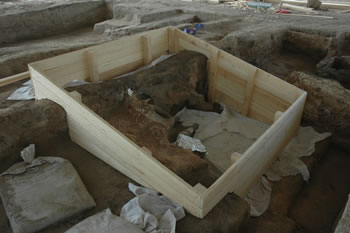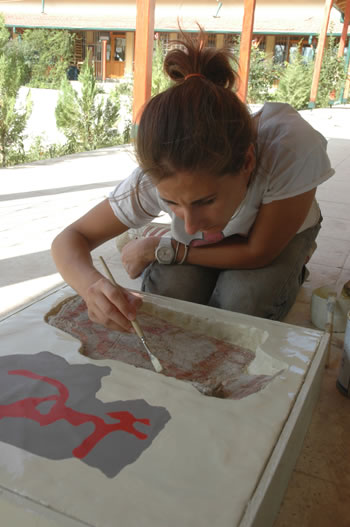CONSERVATION
Duygu Camurcuoglu Cleere, Margrethe Felter
Site and artefacts conservation at Çatalhöyük has been successfully carried out during the 2005 excavation season with the collaboration of conservation students, specialist teams and excavators. Unlike the past two years, two team members (Duygu Camurcuoglu Cleere, Mags Felter) were present on site over the whole season which achieved a continuity of work whilst building up a closer professional relationship with the other specialists. This emphasised the importance of continuity in conservation as a whole and it allowed the conservation support to be a more integrated part of the excavations at Çatalhöyük.
The main activities of the 2005 season were the careful excavation, lifting and treatment of a large number of horn cores, bucrania and other animal bones (see Figures 4, 27 & 28). (Duygu Cleere, Mags Felter, Dominica D’arcangelo, Amy Drago, Glykeria Gkika, Christie Pohl). Like the previous years, the faunal remains team wanted these to be removed from the site in such a condition that they could be measured and studied in the lab. By undertaking the methodology which was developed in the 2004 season, we were able to achieve successful results.

Figure 42. A bespoke structure had to be constructed in situ to protect the bucrania in Building 52. |
A significant discovery in the 2005 season was that of the first full bucranium at Çatalhöyük. The bucranium was found during the excavations of the Building 52 in the 4040 area of Çatalhöyük (see Figure 4). Initially, 12 burnt horn cores that had collapsed on top of each other were excavated and lifted with the joint effort of the faunal remains and the conservation teams (Mags Felter, Christie Pohl). As the excavations continued, a bench was exposed with horn cores set along the edge of the room. Right next to it a very large bull head, lightly plastered, had been set into a niche. The base of the niche had been painted. Since this was a remarkable find, it was decided that it was to be preserved in situ and put on display, as the aim is to cover the 4040 area with a shelter in the near future. Even though the finds were consolidated with 25% Primal AC-33 (acrylic emulsion) in deionised water, they needed to be protected against the environment until the shelter could be constructed. It was decided that a wooden structure (2.20m x 1.90m, pine wood) which would be filled with clean sand, was the best option to cover the room. Local carpenters were employed to build the structure (Figure 42). Firstly the floor was covered with a geotextile layer in order to protect it against any physical damage which may be caused by the structure. Once the structure was built, the surface of the bucranium and the horn cores was covered with aluminium foil as well as supported around with the small sized sand bags. Aluminium foil is easily obtainable and being inert and easy to use, it eliminates the risk of the long term effects of some conservation materials. The structure was filled with clean sand before its lid was attached. Finally, the wood was varnished to make it more durable against the climates and the whole structure was sealed along its base with the Polyurethane foam.
It is recommended that this room is not re-exposed until a shelter is built over the 4040 area since the wooden structure will create a micro environment for the finds inside and any interference may affect the condition of the finds as it will disturb the stable environment in the room.
An important treatment of the 2005 season was the conservation and the mounting of a wall painting to be displayed in Konya Archaeological Museum. This wall painting was discovered in the South (Building 2, Space 117) in 2003, in a niche on one of the walls which was slowly collapsing, but was lifted in two parts and semi conserved during the 2004 season. The upper part was highly damaged, so it was decided that even after conservation, it was not sound enough for the mounting process. The lower part was stronger and therefore it was considered to withstand the mounting. After more stabilisation and aesthetical work done, the wall painting was ready to be mounted.

Figure 43. Mounted wall painting for display in the Konya Archaeological Museum |
The main aim of the mounting process was to use the local materials which would be compatible with the object. Plaster supported with wooden planks was used as a backing material, by using a barrier layer of glass microballoons and 20% Paraloid B72 in Acetone applied on the back of the wall painting. The whole treatment was set in a painted wooden frame and the wall painting was displayed recessed in the plaster in order to represent the niche where it was found. Once the mount was ready, an illustration of the upper part of the wall painting was made by John Swogger in order to inform the visitors that the wall painting has an upper part (Figure 43). An information text was also included, explaining about the wall painting and its conservation.
When the extensive consolidation work undertaken during the 2004 season was re-assessed (4040 area and Building 17), it was clear that an effective stabilisation of plastered surfaces may only be achievable by carrying out a continuous treatment every year. However, it was discussed that this approach may bring up the issue of hardening the plaster layers and thus affecting the ability to explore those layers to reveal paint and pigment if present. For this reason, the conservation team was asked to look at the different strategies for revealing paint in excavated plaster walls. After undertaking some experimental work in the 4040 Area and the Building 17 (Dominica D’arcangelo, Amy Drago, Glykeria Gkika, Jackie Zak), some investigative work was done, with the following objectives:
- to identify particular walls to leave unconsolidated;
- to propose a strategy for local workers to remove plaster on these walls while searching for pigment which may compose a wall painting;
- to suggest a way of documenting this process.
There were several considerations involved with employing local workers in the search for paint within the wall plaster. It was likely that the workers would require clarification and details about the task that would require specialist knowledge. Because paint has never been systematically pursued by the conservation team it was felt that the workers should be supervised by a specialist (an excavator or a conservator) with experience of chasing possible paint and pigment layers. However, there was a concern that the supervision of this work would have taken up too much time both for the excavators and the available conservators. Therefore, it was agreed that Ina St George who has been working on the investigation of paint and pigment layers at Çatalhöyük for the last three years, would be the person to supervise the project